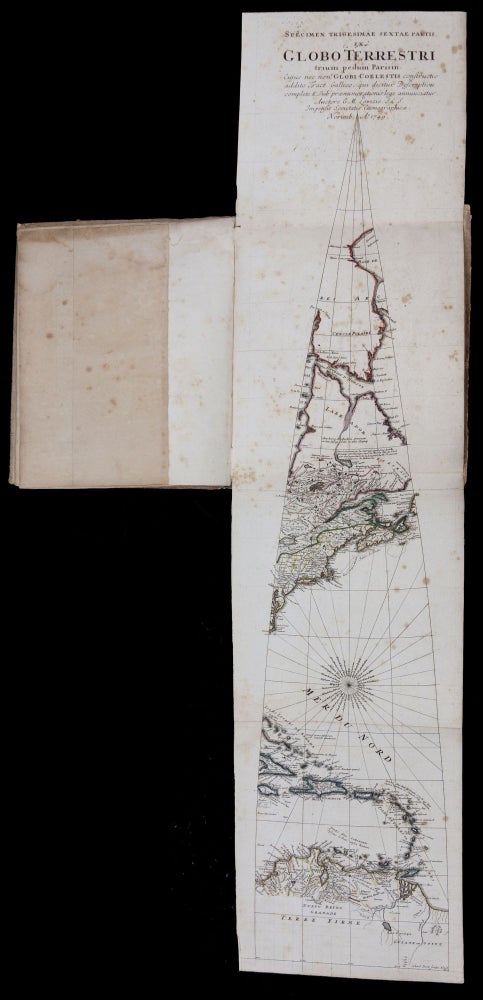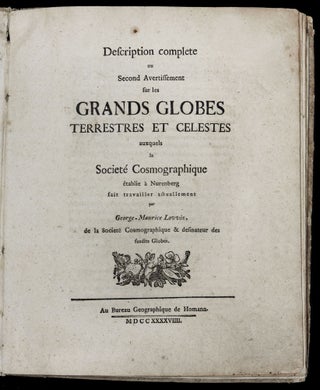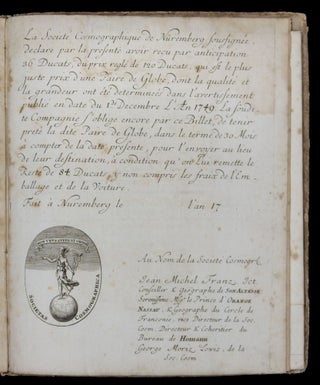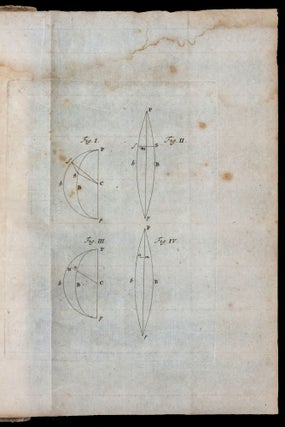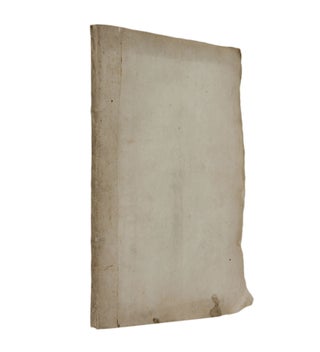Description complete ou Second Avertissement sur les Grands Globes terrestres et celestes.
4to [24.0 x 19.5 cm], 40 pp., with (1) f. engraved ‘form/receipt’, (1) f. engraved geometrical diagram, and (1) engraved 2-sheet folding globe gore with original hand-color. Bound in contemporary paper boards. Spine neatly repaired; some minor staining to boards; toning to letterpress leaves and a bit of foxing and light water staining to engravings. Extremely rare first and only edition of this 1749 prospectus advertising the production of 2 large globes to be constructed according to the most up-to-date mathematical, geographical and astronomical information. These terrestrial and celestial globes, each measuring 3 feet in diameter, were designed by the newly founded Societé Cosmographique (Cosmographische Gesellschaft) in Nuremberg and were to have been produced under the auspices of the renowned cartographic firm of Homann Heirs, then headed by the geographer Johann Michael Franz (1700-61). Included in this explanatory booklet are a large, 2-sheet sample globe gore (in original hand color) showing parts of the Americas as well as an engraved blank ‘form’ which was to be filled out to serve as a receipt for subscribers to the project. The ‘Grands Globes’ project progressed in fits and starts for several years, but was never completed, making the current prospectus an important survival from this ambitious undertaking and, indeed, a valuable witness to the wider state of globe making during an era in which ever more refined standards of scientific accuracy were being applied to this specialized art. The ‘Grand Globes’ project was first announced in 1746 in a 4-page (unillustrated) pamphlet written by Franz under the title Avertissement des Heritiers de Homann, sur la construction de grands globes (Homännischer Bericht von Verfertigung grosser Welt-Kugeln, in the German version). The pamphlet promised that a more extensive publication would soon follow, and the present 40-page Description complete ou Second Avertissement sur les Grands Globes terrestres et celestes fulfilled that promise. The text is by the astronomer/geographer Georg Moriz Lowitz (1722-74), a cofounder of the Cosmographische Gesellschaft along with Franz and the astronomer Tobias Mayer (1723-62). After brief ruminations on the general use and nature of globes, Lowitz carefully describes how the new globes are to be based on the most up-to-date science on the shape of the earth and the configuration of the stars as conveyed in recent publications by Euler, Bernoulli, Klingenstierna, Clairaut and James Bradley. The best and most modern cartographical practices as demonstrated by Bellin, Dobrée, Sonnin, Cassini and others will serve as a guide. Much attention is given to how globe gores will be shaped to fit the sphere (extensive trigonometric equations are provided). Lowitz stresses the high standards of engraving to be used for the gores and describes the (unusual) use of iron for the globe itself, instead of wood, which has a tendency to warp and affect the way the globe spins. Both the engraving of gores and the design of the fixtures (meridian, horizon band, stand) are streamlined for modern usage and stripped of decorative accretions (although deluxe versions with silver fixtures will be available at a premium). Lowitz provides cartographic sources by region. The cartography of the Americas, for example, is based upon the work of D’Anville, Charlevoix, Barriere, and Cadwallader Colden, among others, with high praise reserved for Henry Popple’s multi-sheet map of America (“la Grande Carte de Popple merité le premiére rang” [p. 25]). Three engravings are included with the booklet. One is a geometrical diagram relating to the innovative shape to the gores. Another is the sample gore in full size and with hand-coloring which carries the title Specimen trigesimae sextae partis ex globo terrestri trium pedum Parisin (“Specimen of the 36-part terrestrial globe with a diameter of three Parisian feet”). The gore, engraved by Sebastian Dorn, shows the north American east coast from Newfoundland to Cape Hatteras, the Caribbean from Cuba to the Leeward Islands, and the north coast of South America. The last engraving is a calligraphic form which, upon receipt of a down payment, will be filled out and returned to subscribers as a receipt or ‘proof of purchase’ for the globes, which were guaranteed to be delivered within 30 months. It appears that after the 30 months passed the subscribers became restless, because in 1753 a third notice was published (Troisieme Avertissement sur les Grands Globes où la Societé des Sciences Cosmographiques de Nurenberg rend compte au Public du Retardement de cet ouvrage) in which Lowitz apologized for the delay and offered excuses (problems with financing, difficulties incorporating the new geographic research which was being published all the time). He noted that the iron orbs had been completed, that the fixtures were in progress, and that all gore plates had been engraved. But the project was never finished (see Dekker & Van der Krogt). The present prospectus and completed gore thus are the best surviving witnesses to the ambitious ‘Grands Globes’ venture. OCLC locates no U.S. institutional examples of this prospectus, but the JCB has a copy. (Michigan holds the gore without the booklet).
Price: $7,500.00

